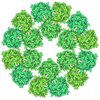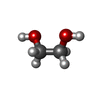[English] 日本語
 Yorodumi
Yorodumi- PDB-3oc9: Crystal structure of putative UDP-N-acetylglucosamine pyrophospho... -
+ Open data
Open data
- Basic information
Basic information
| Entry | Database: PDB / ID: 3oc9 | ||||||
|---|---|---|---|---|---|---|---|
| Title | Crystal structure of putative UDP-N-acetylglucosamine pyrophosphorylase from Entamoeba histolytica | ||||||
 Components Components | UDP-N-acetylglucosamine pyrophosphorylase | ||||||
 Keywords Keywords | TRANSFERASE / Structural Genomics / Seattle Structural Genomics Center for Infectious Disease / SSGCID / anaerobic parasitic protozoan / amoebic dysentery / amoebic liver abscess / cysts / UDP-N-acetylglucosamine diphosphorylase / nucleotidyl transferase | ||||||
| Function / homology |  Function and homology information Function and homology informationUDP-N-acetylglucosamine diphosphorylase / UDP-N-acetylglucosamine diphosphorylase activity / UDP-N-acetylglucosamine biosynthetic process Similarity search - Function | ||||||
| Biological species |  | ||||||
| Method |  X-RAY DIFFRACTION / X-RAY DIFFRACTION /  SYNCHROTRON / SYNCHROTRON /  MOLECULAR REPLACEMENT / Resolution: 1.8 Å MOLECULAR REPLACEMENT / Resolution: 1.8 Å | ||||||
 Authors Authors | Seattle Structural Genomics Center for Infectious Disease (SSGCID) | ||||||
 Citation Citation |  Journal: Acta Crystallogr F Struct Biol Commun / Year: 2015 Journal: Acta Crystallogr F Struct Biol Commun / Year: 2015Title: Structure of uridine diphosphate N-acetylglucosamine pyrophosphorylase from Entamoeba histolytica. Authors: Edwards, T.E. / Gardberg, A.S. / Phan, I.Q. / Zhang, Y. / Staker, B.L. / Myler, P.J. / Lorimer, D.D. | ||||||
| History |
|
- Structure visualization
Structure visualization
| Structure viewer | Molecule:  Molmil Molmil Jmol/JSmol Jmol/JSmol |
|---|
- Downloads & links
Downloads & links
- Download
Download
| PDBx/mmCIF format |  3oc9.cif.gz 3oc9.cif.gz | 183.6 KB | Display |  PDBx/mmCIF format PDBx/mmCIF format |
|---|---|---|---|---|
| PDB format |  pdb3oc9.ent.gz pdb3oc9.ent.gz | 145 KB | Display |  PDB format PDB format |
| PDBx/mmJSON format |  3oc9.json.gz 3oc9.json.gz | Tree view |  PDBx/mmJSON format PDBx/mmJSON format | |
| Others |  Other downloads Other downloads |
-Validation report
| Summary document |  3oc9_validation.pdf.gz 3oc9_validation.pdf.gz | 442.6 KB | Display |  wwPDB validaton report wwPDB validaton report |
|---|---|---|---|---|
| Full document |  3oc9_full_validation.pdf.gz 3oc9_full_validation.pdf.gz | 443.7 KB | Display | |
| Data in XML |  3oc9_validation.xml.gz 3oc9_validation.xml.gz | 19.8 KB | Display | |
| Data in CIF |  3oc9_validation.cif.gz 3oc9_validation.cif.gz | 30.1 KB | Display | |
| Arichive directory |  https://data.pdbj.org/pub/pdb/validation_reports/oc/3oc9 https://data.pdbj.org/pub/pdb/validation_reports/oc/3oc9 ftp://data.pdbj.org/pub/pdb/validation_reports/oc/3oc9 ftp://data.pdbj.org/pub/pdb/validation_reports/oc/3oc9 | HTTPS FTP |
-Related structure data
| Related structure data | 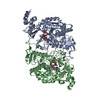 1jv1S S: Starting model for refinement |
|---|---|
| Similar structure data | |
| Other databases |
- Links
Links
- Assembly
Assembly
| Deposited unit | 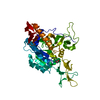
| ||||||||
|---|---|---|---|---|---|---|---|---|---|
| 1 |
| ||||||||
| Unit cell |
|
- Components
Components
| #1: Protein | Mass: 46600.402 Da / Num. of mol.: 1 Source method: isolated from a genetically manipulated source Source: (gene. exp.)  References: UniProt: C4M036, UDP-N-acetylglucosamine diphosphorylase |
|---|---|
| #2: Chemical | ChemComp-SO4 / |
| #3: Chemical | ChemComp-EDO / |
| #4: Water | ChemComp-HOH / |
| Sequence details | THE PLASMID USED TO EXPRESS THE SEQUENCE WAS GENERATED FROM GENOMIC DNA. THE SEQUENCE WAS VERIFIED ...THE PLASMID USED TO EXPRESS THE SEQUENCE WAS GENERATED FROM GENOMIC DNA. THE SEQUENCE WAS VERIFIED IN BOTH THE FORWARD AND REVERSE DIRECTION, YET DIFFERS AT THESE TWO AMINO ACIDS FROM THE PREVIOUSLY |
-Experimental details
-Experiment
| Experiment | Method:  X-RAY DIFFRACTION / Number of used crystals: 1 X-RAY DIFFRACTION / Number of used crystals: 1 |
|---|
- Sample preparation
Sample preparation
| Crystal | Density Matthews: 2.77 Å3/Da / Density % sol: 55.52 % |
|---|---|
| Crystal grow | Temperature: 289 K / Method: vapor diffusion, sitting drop / pH: 5.5 Details: 96.3 mg/mL of EnhiA.01126.b.A1 PS00631 3C cleaved against JCSG+ condition H9, 0.2 M lithium sulfate, 0.1 M BisTris pH 5.5, 25% PEG 3350 with 15% ethylene glycol as cryo-protectant, crystal ...Details: 96.3 mg/mL of EnhiA.01126.b.A1 PS00631 3C cleaved against JCSG+ condition H9, 0.2 M lithium sulfate, 0.1 M BisTris pH 5.5, 25% PEG 3350 with 15% ethylene glycol as cryo-protectant, crystal tracking ID 216241h9, VAPOR DIFFUSION, SITTING DROP, temperature 289K |
-Data collection
| Diffraction | Mean temperature: 100 K | |||||||||||||||||||||||||||||||||||||||||||||||||||||||||||||||||||||||||||||||||||||||||||||||||||||||||||||||||||||||||||||||||||||||||||||||||||
|---|---|---|---|---|---|---|---|---|---|---|---|---|---|---|---|---|---|---|---|---|---|---|---|---|---|---|---|---|---|---|---|---|---|---|---|---|---|---|---|---|---|---|---|---|---|---|---|---|---|---|---|---|---|---|---|---|---|---|---|---|---|---|---|---|---|---|---|---|---|---|---|---|---|---|---|---|---|---|---|---|---|---|---|---|---|---|---|---|---|---|---|---|---|---|---|---|---|---|---|---|---|---|---|---|---|---|---|---|---|---|---|---|---|---|---|---|---|---|---|---|---|---|---|---|---|---|---|---|---|---|---|---|---|---|---|---|---|---|---|---|---|---|---|---|---|---|---|---|
| Diffraction source | Source:  SYNCHROTRON / Site: SYNCHROTRON / Site:  ALS ALS  / Beamline: 5.0.3 / Wavelength: 0.97946 Å / Beamline: 5.0.3 / Wavelength: 0.97946 Å | |||||||||||||||||||||||||||||||||||||||||||||||||||||||||||||||||||||||||||||||||||||||||||||||||||||||||||||||||||||||||||||||||||||||||||||||||||
| Detector | Type: ADSC QUANTUM 315r / Detector: CCD / Date: Jul 31, 2010 | |||||||||||||||||||||||||||||||||||||||||||||||||||||||||||||||||||||||||||||||||||||||||||||||||||||||||||||||||||||||||||||||||||||||||||||||||||
| Radiation | Protocol: SINGLE WAVELENGTH / Monochromatic (M) / Laue (L): M / Scattering type: x-ray | |||||||||||||||||||||||||||||||||||||||||||||||||||||||||||||||||||||||||||||||||||||||||||||||||||||||||||||||||||||||||||||||||||||||||||||||||||
| Radiation wavelength | Wavelength: 0.97946 Å / Relative weight: 1 | |||||||||||||||||||||||||||||||||||||||||||||||||||||||||||||||||||||||||||||||||||||||||||||||||||||||||||||||||||||||||||||||||||||||||||||||||||
| Reflection | Resolution: 1.8→50 Å / Num. all: 48592 / Num. obs: 48589 / % possible obs: 100 % / Observed criterion σ(I): -3 / Redundancy: 9.7 % / Biso Wilson estimate: 32.461 Å2 / Rmerge(I) obs: 0.046 / Net I/σ(I): 30.45 | |||||||||||||||||||||||||||||||||||||||||||||||||||||||||||||||||||||||||||||||||||||||||||||||||||||||||||||||||||||||||||||||||||||||||||||||||||
| Reflection shell | Diffraction-ID: 1
|
-Phasing
| Phasing MR | Rfactor: 59.43 / Model details: Phaser MODE: MR_AUTO
|
|---|
- Processing
Processing
| Software |
| |||||||||||||||||||||||||||||||||||||||||||||||||||||||||||||||||
|---|---|---|---|---|---|---|---|---|---|---|---|---|---|---|---|---|---|---|---|---|---|---|---|---|---|---|---|---|---|---|---|---|---|---|---|---|---|---|---|---|---|---|---|---|---|---|---|---|---|---|---|---|---|---|---|---|---|---|---|---|---|---|---|---|---|---|
| Refinement | Method to determine structure:  MOLECULAR REPLACEMENT MOLECULAR REPLACEMENTStarting model: 1jv1 molecule A residues 68-407 Resolution: 1.8→50 Å / Cor.coef. Fo:Fc: 0.958 / Cor.coef. Fo:Fc free: 0.94 / WRfactor Rfree: 0.224 / WRfactor Rwork: 0.1865 / Occupancy max: 1 / Occupancy min: 0.15 / FOM work R set: 0.8605 / SU B: 5.172 / SU ML: 0.074 / SU R Cruickshank DPI: 0.119 / SU Rfree: 0.1176 / Cross valid method: THROUGHOUT / σ(F): 0 / ESU R Free: 0.118 / Stereochemistry target values: MAXIMUM LIKELIHOOD Details: HYDROGENS HAVE BEEN ADDED IN THE RIDING POSITIONS; U VALUES: WITH TLS ADDED
| |||||||||||||||||||||||||||||||||||||||||||||||||||||||||||||||||
| Solvent computation | Ion probe radii: 0.8 Å / Shrinkage radii: 0.8 Å / VDW probe radii: 1.4 Å / Solvent model: MASK | |||||||||||||||||||||||||||||||||||||||||||||||||||||||||||||||||
| Displacement parameters | Biso max: 89.86 Å2 / Biso mean: 31.9097 Å2 / Biso min: 10.56 Å2
| |||||||||||||||||||||||||||||||||||||||||||||||||||||||||||||||||
| Refinement step | Cycle: LAST / Resolution: 1.8→50 Å
| |||||||||||||||||||||||||||||||||||||||||||||||||||||||||||||||||
| Refine LS restraints |
| |||||||||||||||||||||||||||||||||||||||||||||||||||||||||||||||||
| LS refinement shell | Resolution: 1.8→1.847 Å / Total num. of bins used: 20
| |||||||||||||||||||||||||||||||||||||||||||||||||||||||||||||||||
| Refinement TLS params. | Method: refined / Origin x: 67.9234 Å / Origin y: 70.8686 Å / Origin z: 18.2509 Å
|
 Movie
Movie Controller
Controller


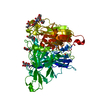
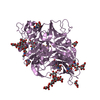
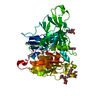
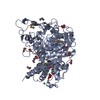
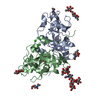
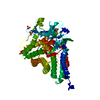



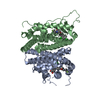
 PDBj
PDBj